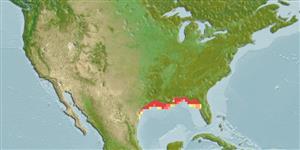Actinopterygii (ray-finned fishes) >
Clupeiformes (Herrings) >
Clupeidae (Herrings, shads, sardines, menhadens) > Alosinae
Etymology: Alosa: Latin, alausa = a fish cited by Ausonius and Latin, halec = pickle, dealing with the Greek word hals = salt; it is also the old Saxon name for shad = "alli" ; 1591 (Ref. 45335); chrysochloris: From the words chryso, meaning gold and chloris, meaning green (Ref. 10294).
Environment / Climate / Range
Ecology
Marine; freshwater; brackish; pelagic-neritic; anadromous (Ref. 51243). Subtropical, preferred ?; 45°N - 23°N, 100°W - 82°W (Ref. 188)
Western Central Atlantic: Gulf of Mexico (from Corpus Christi in Texas eastward to Pensacola in Florida; also in rivers, e.g. Mississippi and Ohio Rivers to Minnesota, Wisconsin and Pennsylvania).
Size / Weight / Age
Maturity: Lm ? range ? - ? cm
Max length : 50.0 cm SL male/unsexed; (Ref. 188); common length : 37.5 cm SL male/unsexed; (Ref. 188); max. published weight: 1.7 kg (Ref. 4699); max. reported age: 4 years (Ref. 12193)
Dorsal
spines
(total): 0;
Anal
spines: 0. Belly with a distinct keel of scutes. Lower jaw not rising steeply within mouth; teeth prominent at front of lower jaw. Lower gill rakers slender. Back bluish green, abruptly changing to silver on flank; no dark spot at shoulder. Closely resembles A. mediocris of Atlantic coasts, which has no upper and weak lower jaw teeth, a dark shoulder spot and the body deeper than head length (Ref. 188).
Generally present in coastal marine water (Ref. 37039). Enter brackish- and freshwaters, but perhaps not always or not consistently anadromous (Ref. 188), although strongly migratory within rivers (Ref. 10294) , mostly in fast-flowing water where they are renowned for leaping. Feed on small fishes, the juveniles on insects. Spawning times and places not certain. Adults serve as hosts to the larvae (glochidia) of the economically valuable pearly mussel (Fusconaia ebena) of the Mississippi basin (Ref. 188).
Life cycle and mating behavior
Maturity | Reproduction | Spawning | Eggs | Fecundity | Larvae
Whitehead, P.J.P., 1985. FAO Species Catalogue. Vol. 7. Clupeoid fishes of the world (suborder Clupeioidei). An annotated and illustrated catalogue of the herrings, sardines, pilchards, sprats, shads, anchovies and wolf-herrings. FAO Fish. Synop. 125(7/1):1-303. Rome: FAO. (Ref. 188)
IUCN Red List Status (Ref. 115185)
CITES (Ref. 94142)
Not Evaluated
Threat to humans
Harmless
Human uses
Fisheries: minor commercial; gamefish: yes
More information
ReferencesAquacultureAquaculture profileStrainsGeneticsAllele frequenciesHeritabilityDiseasesProcessingMass conversion
Tools
Special reports
Download XML
Internet sources
